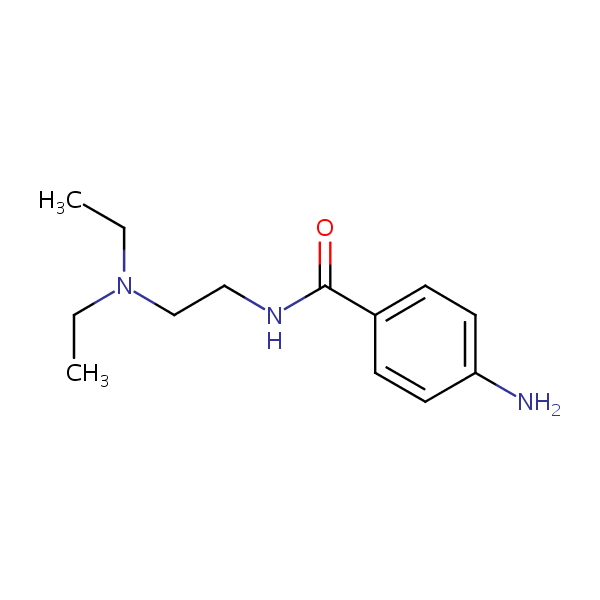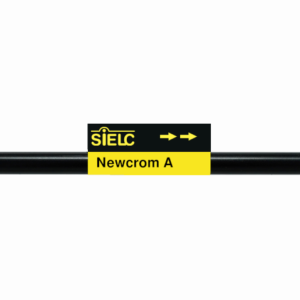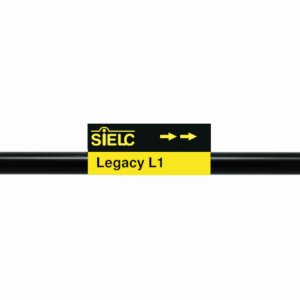| CAS Number | 51-06-9 |
|---|---|
| Molecular Formula | C13H21N3O |
| Molecular Weight | 235.331 |
| InChI Key | REQCZEXYDRLIBE-UHFFFAOYSA-N |
| LogP | 0.88 |
| Synonyms |
|
Applications:
HPLC MS Method for Analysis of Procainamide on Primesep 200 Column
February 15, 2024
HPLC MS Method for Analysis of Procainamide on Primesep 200 Column
Separation type: Liquid Chromatography Mixed-mode SIELC Technologies
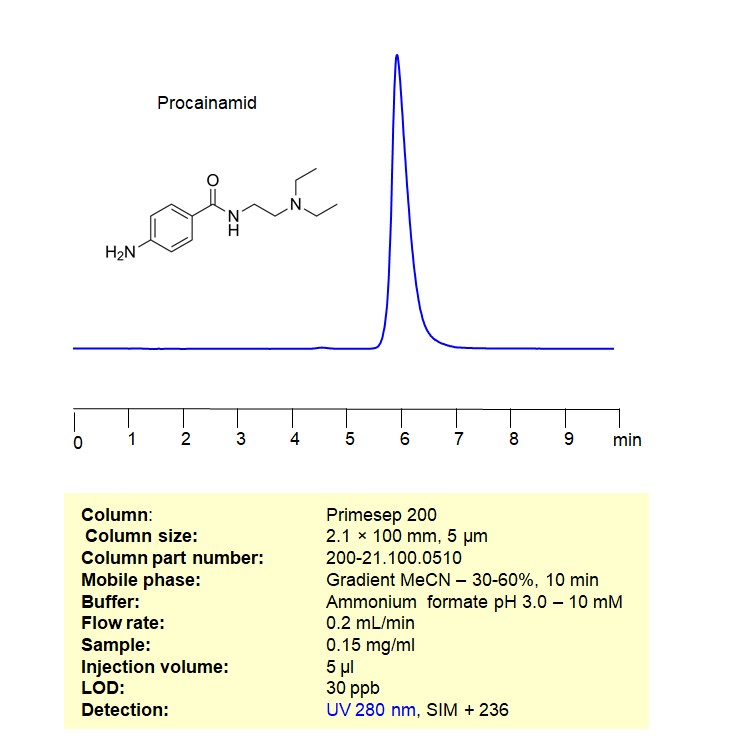
High Performance Liquid Chromatography (HPLC) Method for Analysis of Procainamide
Procainamide is a medication that belongs to the class of antiarrhythmic drugs. It is used to treat certain types of irregular heartbeats (arrhythmias), particularly those associated with atrial and ventricular fibrillation or atrial flutter. Procainamide works by stabilizing the heart’s electrical activity and helping to restore a normal rhythm.
Procainamide blocks sodium channels in the heart, which helps to slow down the conduction of electrical impulses. By doing so, it can prevent abnormal electrical activity in the heart.
Procainamide can be retained and analyzed using a Primesep 200 mixed-mode stationary phase column. The analysis employs an isocratic method with a simple mobile phase comprising water, acetonitrile (MeCN), and ammonium formate as a buffer. This method allows for detection using UV at 280 nm
| Column | Primesep 200, 2.1 x 100 mm, 5 µm, 100 A, dual ended |
| Mobile Phase | Gradient MeCN 30-60%, 10 min |
| Buffer | AmFm pH 3.0 – 10 mM |
| Flow Rate | 0.2 ml/min |
| Detection | UV 280nm, SIM + 236 |
| Samples | 0.15mg/ml |
| Injection volume | 5 µl |
| LOD* | 30 ppb |
| Class of Compounds | Antiarrhythmic agent, Amide |
| Analyzing Compounds | Procainamide |
Application Column
Primesep 200
Column Diameter: 2.1 mm
Column Length: 100 mm
Particle Size: 5 µm
Pore Size: 100 A
Column options: dual ended
LC MS Detection

HPLC Method for Separation of Procainamide and Procaine on BIST B+ Column Column
February 12, 2024
High Performance Liquid Chromatography (HPLC) Method for Analysis of Procainamide, Procaine on BIST B+ by SIELC Technologies
Separation type: Bridge Ion Separation Technology, or BIST™ by SIELC Technologies
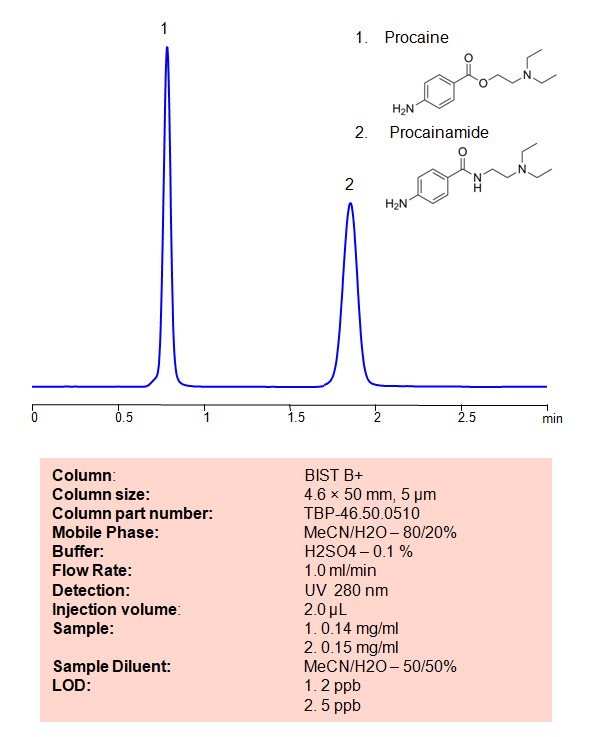
Procainamide and procaine are two different pharmaceutical compounds with distinct uses and properties.
Procainamide:
Class: Procainamide is an antiarrhythmic medication, belonging to the Class Ia antiarrhythmic drugs. It is used to treat certain types of abnormal heart rhythms (arrhythmias) by stabilizing the cell membrane and reducing excitability in the heart muscle.
Mechanism of Action: Procainamide works by inhibiting sodium channels in cardiac cells, prolonging the action potential duration and refractory period, which helps in controlling irregular heartbeats.
Administration: It is typically administered intravenously or orally under medical supervision.
Medical Use: Procainamide is prescribed for conditions such as atrial and ventricular arrhythmias.
Procaine:
Class: Procaine is a local anesthetic drug, belonging to the amino ester group of local anesthetics.
Mechanism of Action: Procaine works by blocking nerve impulses and causing temporary loss of sensation in a specific area of the body.
Administration: It is usually administered through injection to induce local anesthesia. Procaine is commonly used for minor surgical procedures and dental work.
Medical Use: Procaine is employed for local anesthesia, providing pain relief in various medical and dental settings.
Procainamide is primarily used for cardiac conditions, while procaine is utilized as a local anesthetic for pain management during medical and dental procedures. While both compounds have a shared ancestry in PABA and contain amine groups, the specific functional groups (amide vs. ester) and their positions in the molecules contribute to their distinct pharmacological properties. It’s a good observation that small structural changes can lead to significant differences in the pharmacological actions of compounds.
Procainamide and procaine can be retained, separated and analyzed on a BIST B+ mixed-mode stationary phase column using an analytical method with a simple mobile phase of water, Acetonitrile (MeCN) , and a sulfuric acid as a buffer. This analysis method can be detected using UV at 280 nm.
High Performance Liquid Chromatography (HPLC) Method for Analyses of Procainamide, Procaine
Condition
| Column | BIST B+, 4.6 x 50 mm, 5 µm, 100 A, dual ended |
| Mobile Phase | MeCN/H2O – 80/20% |
| Buffe | H2SO4 -0.1% |
| Flow Rate | 1.0 ml/min |
| Detection | UV 280 nm |
| Sample | 1. 0.14 mg/ml 2. 0.15 mg/ml |
| LOD * | 1. 2 ppb 2. 5 ppb |
| Injection volume | 2 µl |
*LOD was determined for this combination of instrument, method, and analyte, and it can vary from one laboratory to another even when the same general type of analysis is being performed
Description
| Class of Compounds | Drug |
| Analyzing Compounds | Procainamide, Procaine |
Application Column
BIST B+
Column Diameter: 4.6 mm
Column Length: 50 mm
Particle Size: 5 µm
Pore Size: 100 A
Column options: dual ended
Procaine

HPLC Method for Separation of Procainamide and Procaine on Newcrom A Column
February 6, 2024
HPLC Method for Analysis of Procainamide, Procaine on Newcrom A by SIELC Technologies
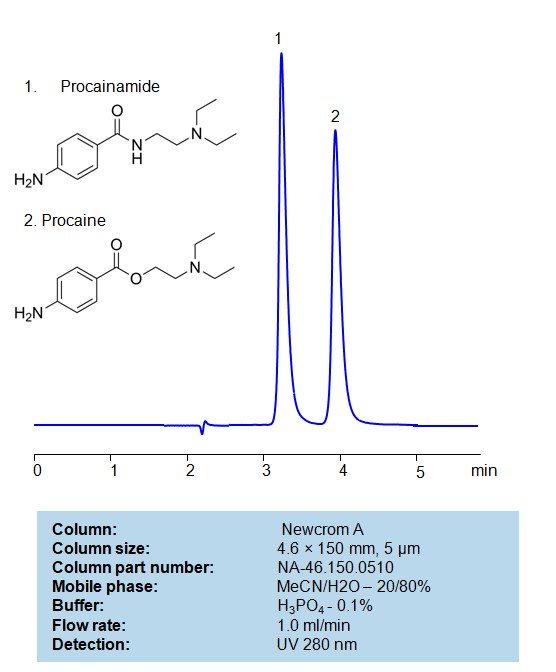
High Performance Liquid Chromatography (HPLC) Method for Analysis of Procainamide, Procaine
Procainamide and procaine are two different pharmaceutical compounds with distinct uses and properties.
Procainamide:
- Class: Procainamide is an antiarrhythmic medication, belonging to the Class Ia antiarrhythmic drugs. It is used to treat certain types of abnormal heart rhythms (arrhythmias) by stabilizing the cell membrane and reducing excitability in the heart muscle.
- Mechanism of Action: Procainamide works by inhibiting sodium channels in cardiac cells, prolonging the action potential duration and refractory period, which helps in controlling irregular heartbeats.
- Administration: It is typically administered intravenously or orally under medical supervision.
- Medical Use: Procainamide is prescribed for conditions such as atrial and ventricular arrhythmias.
Procaine:
- Class: Procaine is a local anesthetic drug, belonging to the amino ester group of local anesthetics.
- Mechanism of Action: Procaine works by blocking nerve impulses and causing temporary loss of sensation in a specific area of the body.
- Administration: It is usually administered through injection to induce local anesthesia. Procaine is commonly used for minor surgical procedures and dental work.
- Medical Use: Procaine is employed for local anesthesia, providing pain relief in various medical and dental settings.
Procainamide is primarily used for cardiac conditions, while procaine is utilized as a local anesthetic for pain management during medical and dental procedures. While both compounds have a shared ancestry in PABA and contain amine groups, the specific functional groups (amide vs. ester) and their positions in the molecules contribute to their distinct pharmacological properties. It’s a good observation that small structural changes can lead to significant differences in the pharmacological actions of compounds.
Procainamide and Procaine can be retained, separated and analyzed using a Newcrom A mixed-mode stationary phase column. The analysis utilizes an isocratic method with a simple mobile phase consisting of water, acetonitrile (MeCN), and phosphoricacid as a buffer. Detection is achieved using UV 280 nm
| Column | Newcrom A, 4.6 x 150 mm, 5 µm, 100 A, dual ended |
| Mobile Phase | MeCN/H2O -20/80% |
| Buffer | H3PO4 – 0.1% |
| Flow Rate | 1.0 ml/min |
| Detection | UV 280 nm |
| Class of Compounds | Drug |
| Analyzing Compounds | Procainamide, Procaine |
Application Column
Newcrom A
Column Diameter: 4.6 mm
Column Length: 150 mm
Particle Size: 5 µm
Pore Size: 100 A
Column options: dual ended
Procaine

USP Methods for the Separation of Propranolol and Procainamide using a Legacy L1 Column
June 21, 2012
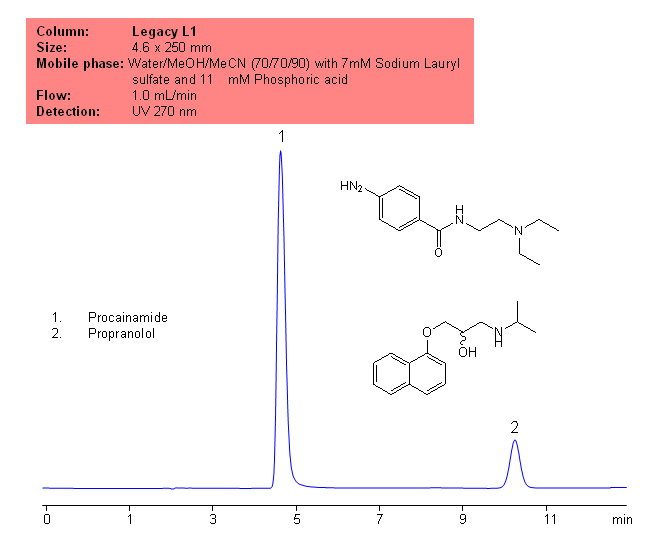
Application Notes:
Propranolol is a common beta-blocker used for treating anxiety and hypertension, and procainamide is an antiarrhythmic drug. According to the USP methods, propranolol hydrochloride contain no less than 98% and no more than 101.5 percent of propranolol calculated on a dried basis. The USP HPLC method for the separation of phenylephrine and epinephrine was developed on Legacy L1 column according to the US Pharmacopeia methodology. L1 classification is assigned to reversed-phase HPLC column containing C18 ligand. Support for the material is spherical silica gel with particles size 3-10 um and pore size of 100-120A. Resolution between critical pairs corresponds to rules and specifications of USP.
Application Columns: Legacy L1 C18 HPLC column
Application compounds: Propranolol and procainamide
Mobile phase: Water/MeOH/MeCN (70/70/90) with 7mM sodium lauryl sulfate and 11 mM phosphoric acid
Detection technique: UV
Reference: USP35: NF30
| Column | Legacy L1, 4.6×150 mm, 5 µm, 100A |
| Mobile Phase | Water/MeOH/MeCN (70/70/90) with 7mM Sodium Lauryl sulfate and 11 mM Phosphoric acid |
| Buffer | Sodium Lauryl Sulfate, Phosphoric acid |
| Flow Rate | 1.0 ml/min |
| Detection | UV, 270 nm |
| Class of Compounds |
Drug, Beta blocker, Antiarrhythmic, Hydrophobic, Ionizable, Neutral |
| Analyzing Compounds | Propranolol, Procainamide |
Application Column
Legacy L1
SIELC's family of Legacy columns is based on the United States Pharmacopeia's (USP) published chromatographic methods and procedures. Numerous brands have columns used in USP reference standards and methods. USP has created various designations to group together columns with similar types of packing and properties in the solid phase. SIELC's Legacy columns adhere to these strict requirements and properties, allowing you to easily replace older columns that are no longer available without needing to significantly modify your method or SOPs.
Select optionsProcainamide

USP Methods Analysis of Procainamide on Legacy L1 Column
June 21, 2012
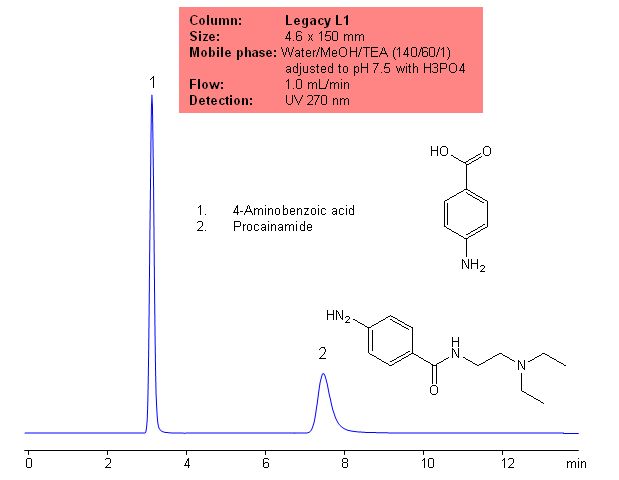
Application Columns: Legacy L1 C18 HPLC column
Application compounds: Procainamide and 4-aminobenzoic acid
Mobile phase: WAter/MeOH/MeCN (70/70/90) with 7 mM sodium lauryl sulfate and 11mM phosphoric acid
Detection technique: UV
Reference: USP35: NF30
| Column | Legacy L1, 4.6×150 mm, 5 µm, 100A |
| Mobile Phase | Water/MeOH/TEA (140/60/1) adjusted to pH 7.5 with H3PO4 |
| Buffer | TEAPh |
| Flow Rate | 1.5 ml/min |
| Detection | UV, 230 nm |
| Class of Compounds |
Drug, Nonsteroidal anti-inflammatory drug, Hydrophobic, Ionizable |
| Analyzing Compounds | Ibuprofen, benzophenone |
Application Column
Legacy L1
SIELC's family of Legacy columns is based on the United States Pharmacopeia's (USP) published chromatographic methods and procedures. Numerous brands have columns used in USP reference standards and methods. USP has created various designations to group together columns with similar types of packing and properties in the solid phase. SIELC's Legacy columns adhere to these strict requirements and properties, allowing you to easily replace older columns that are no longer available without needing to significantly modify your method or SOPs.
Select optionsProcainamide
Procainamide Hydrochloride

